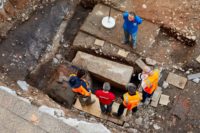 A Merovingian-era sarcophagus dating to the 7th century has been discovered in Cahors, Lot Department, southwestern France. Department archaeologists were excavating the courtyard of a public building in anticipation of future construction when they unearthed a large limestone coffin. The rectangular sarcophagus was topped with a four-sided gabled lid and was unbroken. The lid was still sealed to the box, its mortar joint unbroken. The find is unprecedented and of great significance to archaeologists because little is known about Merovingian Cahors.
A Merovingian-era sarcophagus dating to the 7th century has been discovered in Cahors, Lot Department, southwestern France. Department archaeologists were excavating the courtyard of a public building in anticipation of future construction when they unearthed a large limestone coffin. The rectangular sarcophagus was topped with a four-sided gabled lid and was unbroken. The lid was still sealed to the box, its mortar joint unbroken. The find is unprecedented and of great significance to archaeologists because little is known about Merovingian Cahors.
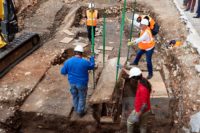 Archaeologists passed an endoscope through a crack in the stone to establish whether the sarcophagus’ contents were intact. They confirmed that skeletal remains were undisturbed inside the coffin before attempting to open the heavy lid. On Tuesday, August 13th, the limestone lid was strapped to a mechanical digger and carefully raised.
Archaeologists passed an endoscope through a crack in the stone to establish whether the sarcophagus’ contents were intact. They confirmed that skeletal remains were undisturbed inside the coffin before attempting to open the heavy lid. On Tuesday, August 13th, the limestone lid was strapped to a mechanical digger and carefully raised.
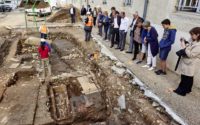 Forensic anthropologists from the National Institute for Preventive Archaeological Research (INRAP) worked with the Lot archaeologists to excavate and examine the burial. Initial analysis found the remains belonged to an elderly woman with the tell-tale lesions of osteoarthritis on her bones. There were no grave goods inside the coffin which is a common feature of Christian burials.
Forensic anthropologists from the National Institute for Preventive Archaeological Research (INRAP) worked with the Lot archaeologists to excavate and examine the burial. Initial analysis found the remains belonged to an elderly woman with the tell-tale lesions of osteoarthritis on her bones. There were no grave goods inside the coffin which is a common feature of Christian burials.
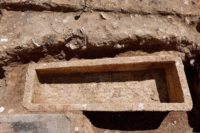 The find site is believed to have been on the property of a monastery founded by Desiderius (aka Didier) of Cahors, a 7th century aristocrat with close ties to Merovingian royalty who in his role as bishop of Cahors built multiple churches and monasteries in the area. Desiderius was renown for building in the Roman style — cut stone blocks rather than wood, wattle and daub — and he founded at least one convent for women. The sarcophagus appears to have been placed in a passageway (possibly the cloister), an indication that she must have been someone of importance.
The find site is believed to have been on the property of a monastery founded by Desiderius (aka Didier) of Cahors, a 7th century aristocrat with close ties to Merovingian royalty who in his role as bishop of Cahors built multiple churches and monasteries in the area. Desiderius was renown for building in the Roman style — cut stone blocks rather than wood, wattle and daub — and he founded at least one convent for women. The sarcophagus appears to have been placed in a passageway (possibly the cloister), an indication that she must have been someone of importance.
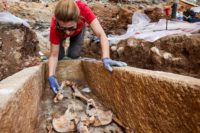 The bones have been removed from the sarcophagus and will be studied further at an INRAP laboratory. The remains will be radiocarbon dated to narrow down when the woman died. The preliminary dating to the 7th century is based on layer archaeology. Ongoing excavations have found pottery from the period and what is believed to be the remains of an old kitchen.
The bones have been removed from the sarcophagus and will be studied further at an INRAP laboratory. The remains will be radiocarbon dated to narrow down when the woman died. The preliminary dating to the 7th century is based on layer archaeology. Ongoing excavations have found pottery from the period and what is believed to be the remains of an old kitchen.
The sarcophagus and its lid are destined for the Musée de Cahors Henri-Martin, currently closed for renovations with reopening scheduled for early 2020. The museum is named after impressionist painter Henri-Jean Guillaume Martin and is known for its collection and temporary exhibition of work by artists from the 20th century to the present, but it also has a significant collection of archaeological artifacts from the region.
I am always fascinated by the willingness of archeologists to undertake everything possible in a hole in the ground. Why not lift the whole sarcophagus out before opening it?
Good point! — The pit is seemingly an extremely narrow one, the sarcophagus plus lid extremely heavy, and maybe they were worrying that the brittle stone might brake into pieces. Also, I wonder, how it had been lowered in the first place.
Apart from that, I am the proud owner of a book on the Merovingian Franks. In Christian burials there are indeed less grave goods, but Warrior graves and female Royalty still seem to have a considerable amount of them, the warriors mainly weapons.
Apparently, in Aquitaine –i.e. including Cahors– the Visigoths had settled as foederati to the Romans – a relationship established in 418, i.e. until in 507AD, Clovis I defeated them in the Battle of Vouillé. Maybe she was Visigothic in a Frankish cloister? 𐌾𐌰𐌷 𐍅𐌿𐌻𐌸𐌿𐍃 𐌹𐌽 𐌰𐌹𐍅𐌹𐌽𐍃
I agree. Seems a little rude to the dead person to open it like they did. While I am always fascinated by history and what we can find, it does make me want to be cremated. I don’t want my bones displayed for all to see hundreds (thousands) of years later. A little respect would be nice. Hope they said a prayer of sorts.